Competitive Strategy: An Analysis of Carlsberg Business Strategies
VerifiedAdded on 2022/11/10
|16
|4047
|3
Report
AI Summary
This report provides an in-depth analysis of Carlsberg's business strategies within the brewery industry. The study examines Carlsberg's competitive landscape, including its strategic issues, mergers and acquisitions, and the application of various strategy models such as Porter's Five Forces and PESTEL analysis. The report explores Carlsberg's historical development, internal strengths and weaknesses, and the macro-environmental factors influencing its operations. It highlights the company's efforts to achieve a competitive advantage through innovation, market positioning, and diversification. The analysis focuses on the challenges posed by market competition, political and economic factors, and the need for strategic adaptation. Recommendations include diversification into health-enhancing beverages, high-quality products at low costs, and market research to align with consumer preferences.
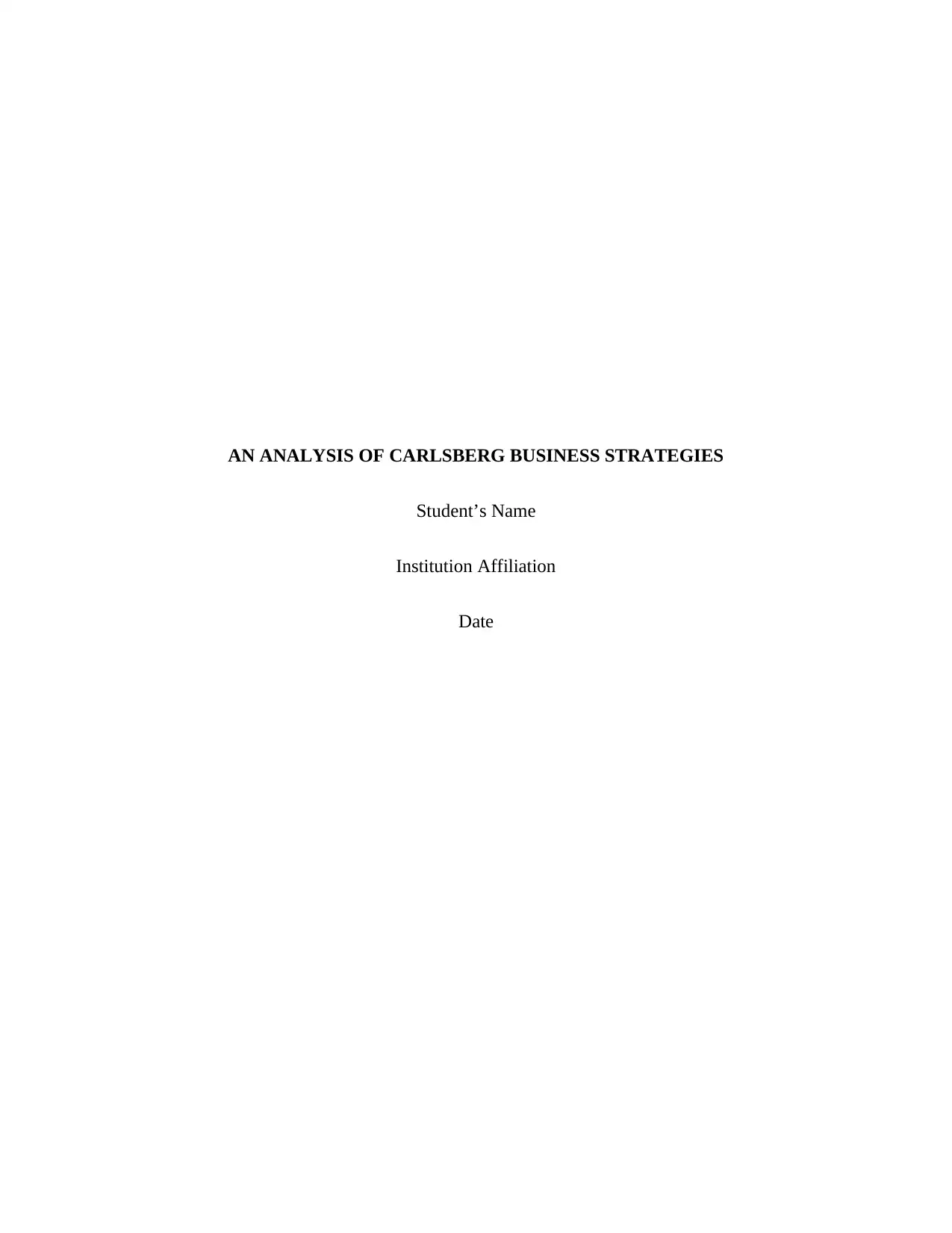
AN ANALYSIS OF CARLSBERG BUSINESS STRATEGIES
Student’s Name
Institution Affiliation
Date
Student’s Name
Institution Affiliation
Date
Paraphrase This Document
Need a fresh take? Get an instant paraphrase of this document with our AI Paraphraser
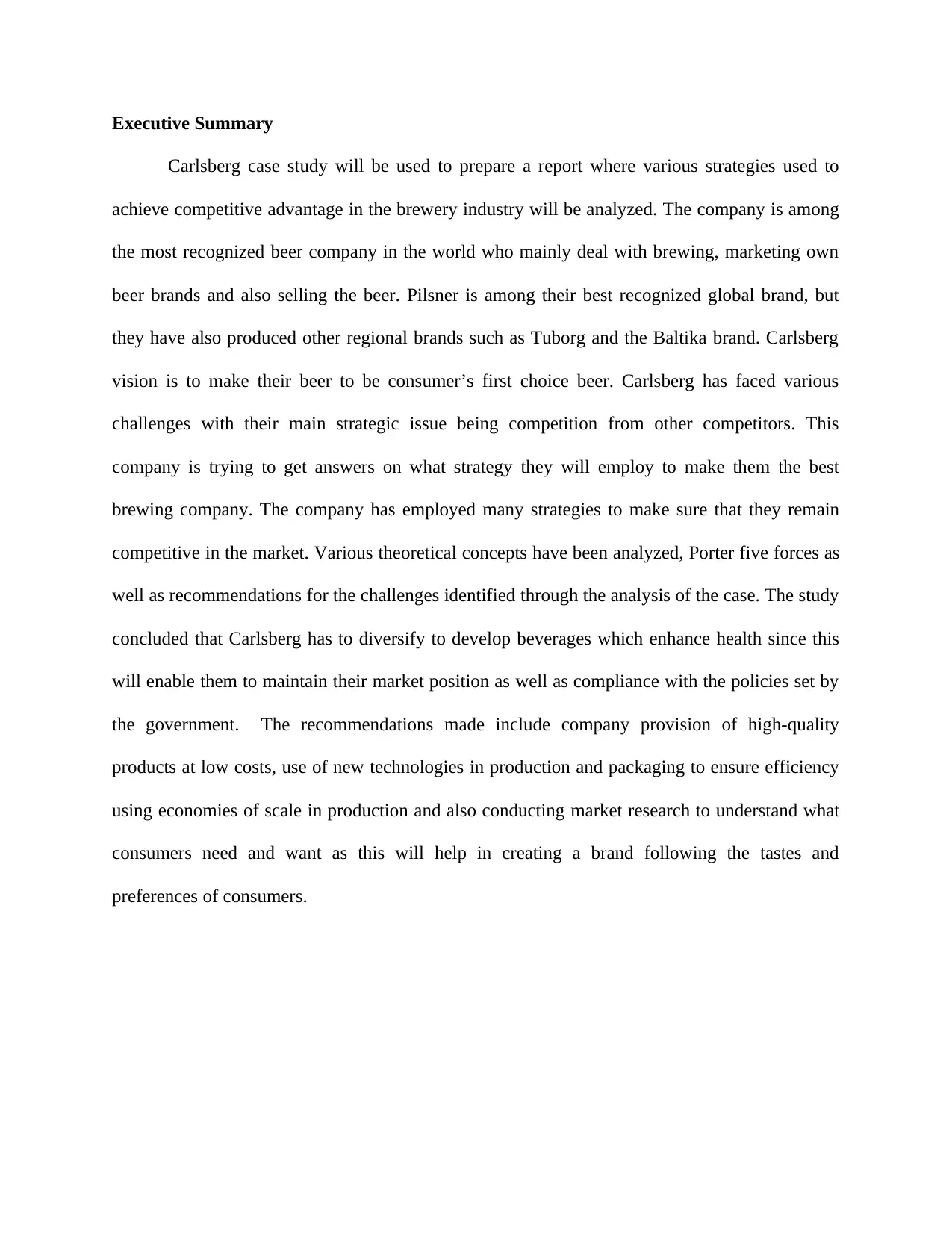
Executive Summary
Carlsberg case study will be used to prepare a report where various strategies used to
achieve competitive advantage in the brewery industry will be analyzed. The company is among
the most recognized beer company in the world who mainly deal with brewing, marketing own
beer brands and also selling the beer. Pilsner is among their best recognized global brand, but
they have also produced other regional brands such as Tuborg and the Baltika brand. Carlsberg
vision is to make their beer to be consumer’s first choice beer. Carlsberg has faced various
challenges with their main strategic issue being competition from other competitors. This
company is trying to get answers on what strategy they will employ to make them the best
brewing company. The company has employed many strategies to make sure that they remain
competitive in the market. Various theoretical concepts have been analyzed, Porter five forces as
well as recommendations for the challenges identified through the analysis of the case. The study
concluded that Carlsberg has to diversify to develop beverages which enhance health since this
will enable them to maintain their market position as well as compliance with the policies set by
the government. The recommendations made include company provision of high-quality
products at low costs, use of new technologies in production and packaging to ensure efficiency
using economies of scale in production and also conducting market research to understand what
consumers need and want as this will help in creating a brand following the tastes and
preferences of consumers.
Carlsberg case study will be used to prepare a report where various strategies used to
achieve competitive advantage in the brewery industry will be analyzed. The company is among
the most recognized beer company in the world who mainly deal with brewing, marketing own
beer brands and also selling the beer. Pilsner is among their best recognized global brand, but
they have also produced other regional brands such as Tuborg and the Baltika brand. Carlsberg
vision is to make their beer to be consumer’s first choice beer. Carlsberg has faced various
challenges with their main strategic issue being competition from other competitors. This
company is trying to get answers on what strategy they will employ to make them the best
brewing company. The company has employed many strategies to make sure that they remain
competitive in the market. Various theoretical concepts have been analyzed, Porter five forces as
well as recommendations for the challenges identified through the analysis of the case. The study
concluded that Carlsberg has to diversify to develop beverages which enhance health since this
will enable them to maintain their market position as well as compliance with the policies set by
the government. The recommendations made include company provision of high-quality
products at low costs, use of new technologies in production and packaging to ensure efficiency
using economies of scale in production and also conducting market research to understand what
consumers need and want as this will help in creating a brand following the tastes and
preferences of consumers.
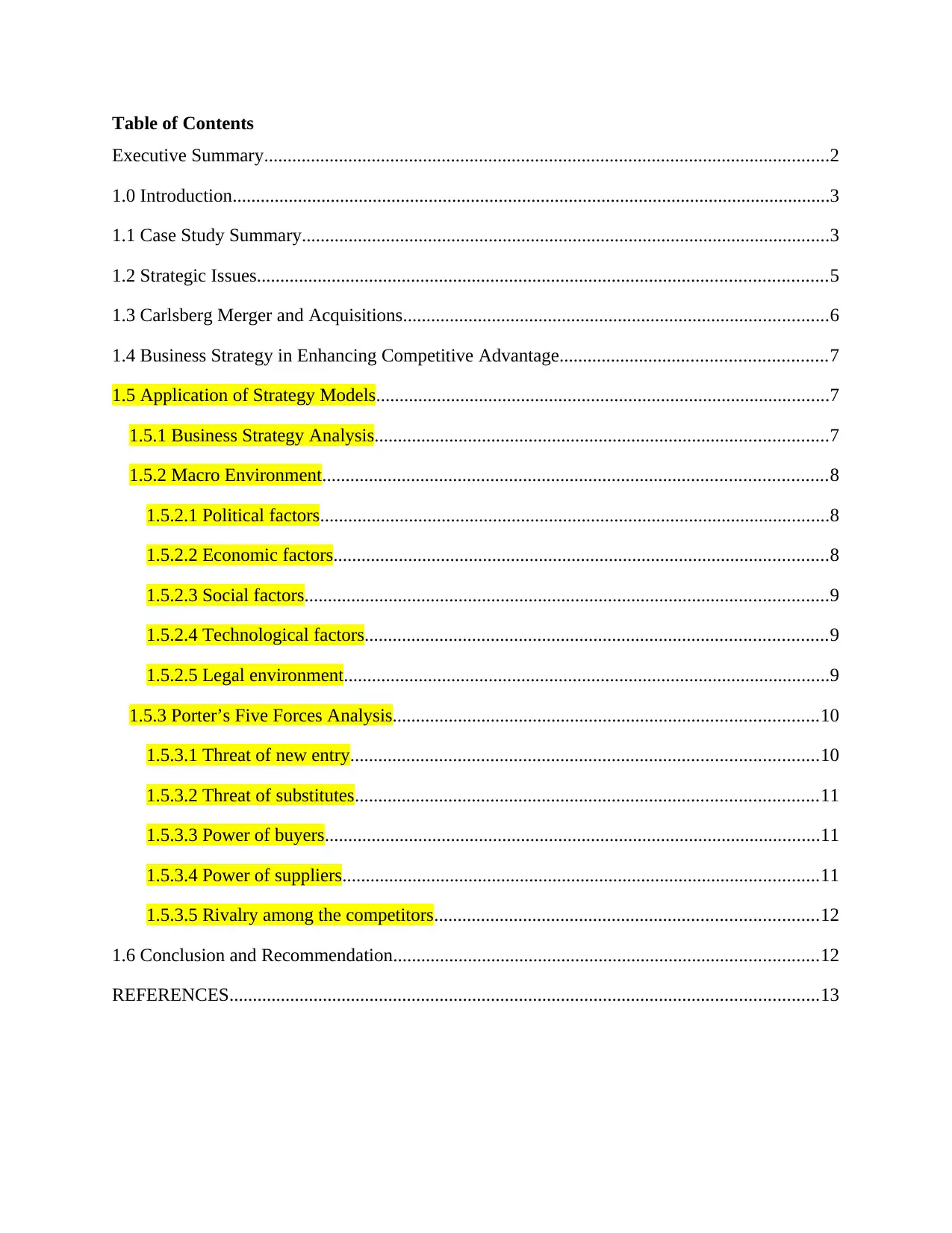
Table of Contents
Executive Summary.........................................................................................................................2
1.0 Introduction................................................................................................................................3
1.1 Case Study Summary.................................................................................................................3
1.2 Strategic Issues..........................................................................................................................5
1.3 Carlsberg Merger and Acquisitions...........................................................................................6
1.4 Business Strategy in Enhancing Competitive Advantage.........................................................7
1.5 Application of Strategy Models.................................................................................................7
1.5.1 Business Strategy Analysis.................................................................................................7
1.5.2 Macro Environment............................................................................................................8
1.5.2.1 Political factors.............................................................................................................8
1.5.2.2 Economic factors..........................................................................................................8
1.5.2.3 Social factors................................................................................................................9
1.5.2.4 Technological factors...................................................................................................9
1.5.2.5 Legal environment........................................................................................................9
1.5.3 Porter’s Five Forces Analysis...........................................................................................10
1.5.3.1 Threat of new entry....................................................................................................10
1.5.3.2 Threat of substitutes...................................................................................................11
1.5.3.3 Power of buyers..........................................................................................................11
1.5.3.4 Power of suppliers......................................................................................................11
1.5.3.5 Rivalry among the competitors..................................................................................12
1.6 Conclusion and Recommendation...........................................................................................12
REFERENCES..............................................................................................................................13
Executive Summary.........................................................................................................................2
1.0 Introduction................................................................................................................................3
1.1 Case Study Summary.................................................................................................................3
1.2 Strategic Issues..........................................................................................................................5
1.3 Carlsberg Merger and Acquisitions...........................................................................................6
1.4 Business Strategy in Enhancing Competitive Advantage.........................................................7
1.5 Application of Strategy Models.................................................................................................7
1.5.1 Business Strategy Analysis.................................................................................................7
1.5.2 Macro Environment............................................................................................................8
1.5.2.1 Political factors.............................................................................................................8
1.5.2.2 Economic factors..........................................................................................................8
1.5.2.3 Social factors................................................................................................................9
1.5.2.4 Technological factors...................................................................................................9
1.5.2.5 Legal environment........................................................................................................9
1.5.3 Porter’s Five Forces Analysis...........................................................................................10
1.5.3.1 Threat of new entry....................................................................................................10
1.5.3.2 Threat of substitutes...................................................................................................11
1.5.3.3 Power of buyers..........................................................................................................11
1.5.3.4 Power of suppliers......................................................................................................11
1.5.3.5 Rivalry among the competitors..................................................................................12
1.6 Conclusion and Recommendation...........................................................................................12
REFERENCES..............................................................................................................................13
⊘ This is a preview!⊘
Do you want full access?
Subscribe today to unlock all pages.

Trusted by 1+ million students worldwide

1.0 Introduction
1.1 Case Study Summary
Carlsberg is one among the well-recognized beer company in the world. The company’s main
business conducted include brewing, marketing their beer brands, and also selling their beer.
Their vision was to make their beer the first choice for consumers among other brands. Among
the markets targeted by Carlsberg included eastern and western Europe as well as the Asian
market (Kjeldgaard et al., 205). According to the case study, this company has an objective of
ensuring that they get more market share by tapping the emerging beer market, especially in the
western European beer market. The Russian market was considered to be the market which was
growing very first but to win the market Carlsberg acquired the Baltic Beverages Holding (BBH)
which gave them a competitive advantage and they were able to control the market (Madsen,
2019).
The Danish company was able to control the Chinese market, where it owned approximately
55% of the market share. According to the case study, the company was about to fail in the early
2000s in the Chinese market due to the increased level of competition in the market that was
booming. China beer market was considered to be the largest market due to its large population
though for a company to be able to operate in this market it needed to spend more time and
resources as this market had a lot of competition (Lasserre, 2017). For Carlsberg to do the
business it needed to employ unconventional strategies to do away with their immediate
competitors who included the Heineken, In Bev, SAB Miller and also a Hauser Busch. Carlsberg
employed the strategy of quality, innovation and also a continuous improvement to gain a
competitive advantage (Kotabe and Helsen, 2014).
1.1 Case Study Summary
Carlsberg is one among the well-recognized beer company in the world. The company’s main
business conducted include brewing, marketing their beer brands, and also selling their beer.
Their vision was to make their beer the first choice for consumers among other brands. Among
the markets targeted by Carlsberg included eastern and western Europe as well as the Asian
market (Kjeldgaard et al., 205). According to the case study, this company has an objective of
ensuring that they get more market share by tapping the emerging beer market, especially in the
western European beer market. The Russian market was considered to be the market which was
growing very first but to win the market Carlsberg acquired the Baltic Beverages Holding (BBH)
which gave them a competitive advantage and they were able to control the market (Madsen,
2019).
The Danish company was able to control the Chinese market, where it owned approximately
55% of the market share. According to the case study, the company was about to fail in the early
2000s in the Chinese market due to the increased level of competition in the market that was
booming. China beer market was considered to be the largest market due to its large population
though for a company to be able to operate in this market it needed to spend more time and
resources as this market had a lot of competition (Lasserre, 2017). For Carlsberg to do the
business it needed to employ unconventional strategies to do away with their immediate
competitors who included the Heineken, In Bev, SAB Miller and also a Hauser Busch. Carlsberg
employed the strategy of quality, innovation and also a continuous improvement to gain a
competitive advantage (Kotabe and Helsen, 2014).
Paraphrase This Document
Need a fresh take? Get an instant paraphrase of this document with our AI Paraphraser

Every market adopted a marketing strategy which differed from one market to another. For the
Western Europe market, a strategy of improved profitability through the use of innovation was
adopted (Chesbrough et al., 2018), in Asian market, they adopted a strategy of “long term growth
through market position building” and in the Eastern Europe market the strategy used was the
rapid growth and higher-earning (Hatch and Schultz, 2017). Though the main focus of this
company was in Western Europe in early 1968 it opened their first foreign brewing in Malawi in
Africa (Gammelgaard, 2015). This company was not only facing competition from other brewing
industries; it also faced competition from wines and spirit. Pilsner is Carlsberg’s best-known
global brand, but they also produced other regional brands such as Tuborg and the Baltika brand
(Binder and Mantovani, 2017). The company faced a problem of blocked potential fusion with
the foreign industries and also a shortage of fund as they relied on their main shareholder who
was the Carlsberg foundation who were responsible for funding their scientific researches and
also social works (Papazov and Mihaylova, 2015).
1.2 Strategic Issues
Carlsberg has many challenges affecting their operation and their mission and visions. The main
strategic issue is competition the company is facing from other competitors. This company is
trying to get answers on what strategy they will employ to make it the best brewing company.
The company was ranked to be the fifth-best brewing company in the world (Madsen, 2019). It
faced stiff competition from the Heineken, In Bev, SAB Miller and also a Hauser Busch brewing
companies (Buckley and Ghauri, 2015). They also faced competition from local brewers who
sold their beer at low prices. They also faced competition from the wines and spirit dealers in the
same market position. This company targeted China and mainly western Europe due to its large
Western Europe market, a strategy of improved profitability through the use of innovation was
adopted (Chesbrough et al., 2018), in Asian market, they adopted a strategy of “long term growth
through market position building” and in the Eastern Europe market the strategy used was the
rapid growth and higher-earning (Hatch and Schultz, 2017). Though the main focus of this
company was in Western Europe in early 1968 it opened their first foreign brewing in Malawi in
Africa (Gammelgaard, 2015). This company was not only facing competition from other brewing
industries; it also faced competition from wines and spirit. Pilsner is Carlsberg’s best-known
global brand, but they also produced other regional brands such as Tuborg and the Baltika brand
(Binder and Mantovani, 2017). The company faced a problem of blocked potential fusion with
the foreign industries and also a shortage of fund as they relied on their main shareholder who
was the Carlsberg foundation who were responsible for funding their scientific researches and
also social works (Papazov and Mihaylova, 2015).
1.2 Strategic Issues
Carlsberg has many challenges affecting their operation and their mission and visions. The main
strategic issue is competition the company is facing from other competitors. This company is
trying to get answers on what strategy they will employ to make it the best brewing company.
The company was ranked to be the fifth-best brewing company in the world (Madsen, 2019). It
faced stiff competition from the Heineken, In Bev, SAB Miller and also a Hauser Busch brewing
companies (Buckley and Ghauri, 2015). They also faced competition from local brewers who
sold their beer at low prices. They also faced competition from the wines and spirit dealers in the
same market position. This company targeted China and mainly western Europe due to its large
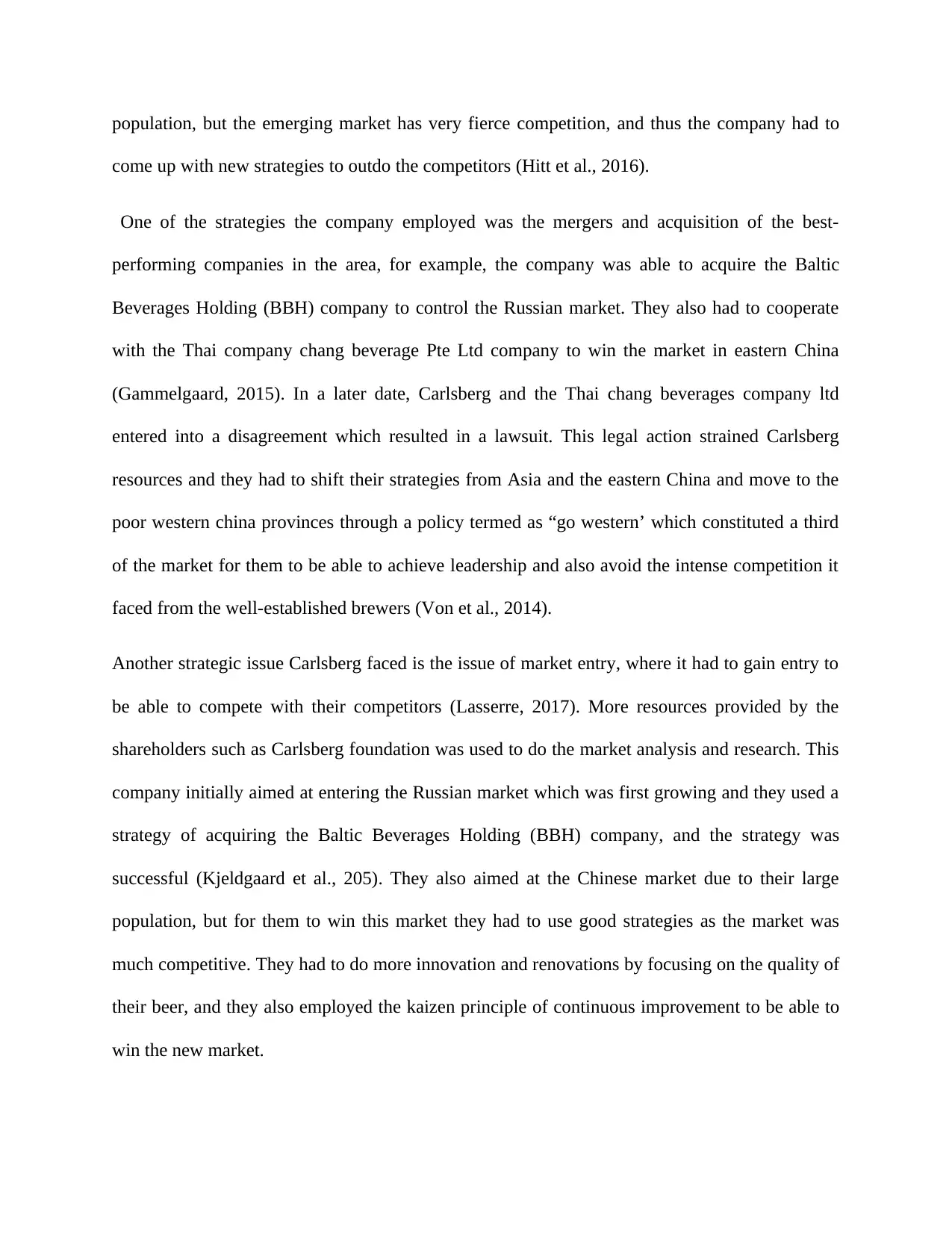
population, but the emerging market has very fierce competition, and thus the company had to
come up with new strategies to outdo the competitors (Hitt et al., 2016).
One of the strategies the company employed was the mergers and acquisition of the best-
performing companies in the area, for example, the company was able to acquire the Baltic
Beverages Holding (BBH) company to control the Russian market. They also had to cooperate
with the Thai company chang beverage Pte Ltd company to win the market in eastern China
(Gammelgaard, 2015). In a later date, Carlsberg and the Thai chang beverages company ltd
entered into a disagreement which resulted in a lawsuit. This legal action strained Carlsberg
resources and they had to shift their strategies from Asia and the eastern China and move to the
poor western china provinces through a policy termed as “go western’ which constituted a third
of the market for them to be able to achieve leadership and also avoid the intense competition it
faced from the well-established brewers (Von et al., 2014).
Another strategic issue Carlsberg faced is the issue of market entry, where it had to gain entry to
be able to compete with their competitors (Lasserre, 2017). More resources provided by the
shareholders such as Carlsberg foundation was used to do the market analysis and research. This
company initially aimed at entering the Russian market which was first growing and they used a
strategy of acquiring the Baltic Beverages Holding (BBH) company, and the strategy was
successful (Kjeldgaard et al., 205). They also aimed at the Chinese market due to their large
population, but for them to win this market they had to use good strategies as the market was
much competitive. They had to do more innovation and renovations by focusing on the quality of
their beer, and they also employed the kaizen principle of continuous improvement to be able to
win the new market.
come up with new strategies to outdo the competitors (Hitt et al., 2016).
One of the strategies the company employed was the mergers and acquisition of the best-
performing companies in the area, for example, the company was able to acquire the Baltic
Beverages Holding (BBH) company to control the Russian market. They also had to cooperate
with the Thai company chang beverage Pte Ltd company to win the market in eastern China
(Gammelgaard, 2015). In a later date, Carlsberg and the Thai chang beverages company ltd
entered into a disagreement which resulted in a lawsuit. This legal action strained Carlsberg
resources and they had to shift their strategies from Asia and the eastern China and move to the
poor western china provinces through a policy termed as “go western’ which constituted a third
of the market for them to be able to achieve leadership and also avoid the intense competition it
faced from the well-established brewers (Von et al., 2014).
Another strategic issue Carlsberg faced is the issue of market entry, where it had to gain entry to
be able to compete with their competitors (Lasserre, 2017). More resources provided by the
shareholders such as Carlsberg foundation was used to do the market analysis and research. This
company initially aimed at entering the Russian market which was first growing and they used a
strategy of acquiring the Baltic Beverages Holding (BBH) company, and the strategy was
successful (Kjeldgaard et al., 205). They also aimed at the Chinese market due to their large
population, but for them to win this market they had to use good strategies as the market was
much competitive. They had to do more innovation and renovations by focusing on the quality of
their beer, and they also employed the kaizen principle of continuous improvement to be able to
win the new market.
⊘ This is a preview!⊘
Do you want full access?
Subscribe today to unlock all pages.

Trusted by 1+ million students worldwide
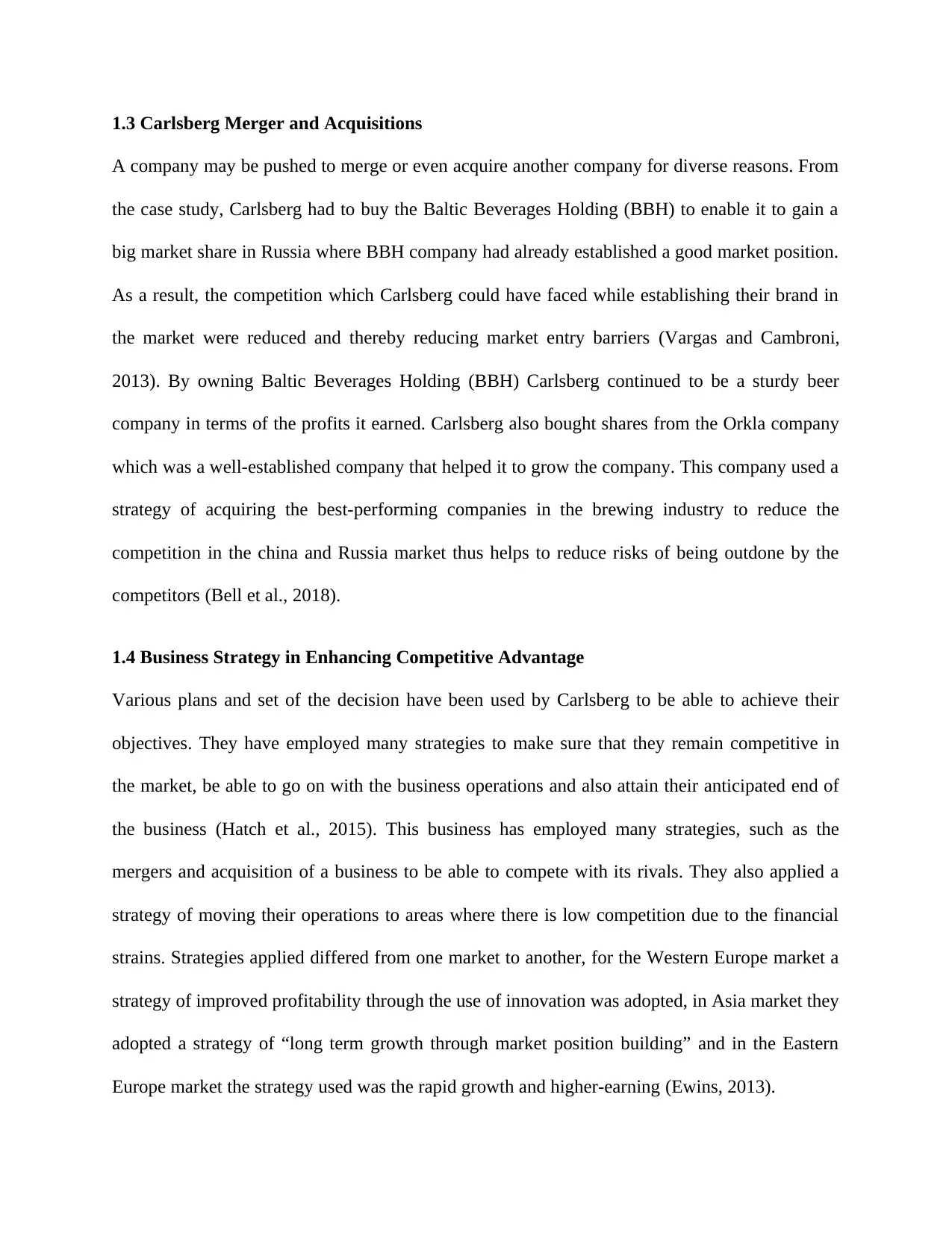
1.3 Carlsberg Merger and Acquisitions
A company may be pushed to merge or even acquire another company for diverse reasons. From
the case study, Carlsberg had to buy the Baltic Beverages Holding (BBH) to enable it to gain a
big market share in Russia where BBH company had already established a good market position.
As a result, the competition which Carlsberg could have faced while establishing their brand in
the market were reduced and thereby reducing market entry barriers (Vargas and Cambroni,
2013). By owning Baltic Beverages Holding (BBH) Carlsberg continued to be a sturdy beer
company in terms of the profits it earned. Carlsberg also bought shares from the Orkla company
which was a well-established company that helped it to grow the company. This company used a
strategy of acquiring the best-performing companies in the brewing industry to reduce the
competition in the china and Russia market thus helps to reduce risks of being outdone by the
competitors (Bell et al., 2018).
1.4 Business Strategy in Enhancing Competitive Advantage
Various plans and set of the decision have been used by Carlsberg to be able to achieve their
objectives. They have employed many strategies to make sure that they remain competitive in
the market, be able to go on with the business operations and also attain their anticipated end of
the business (Hatch et al., 2015). This business has employed many strategies, such as the
mergers and acquisition of a business to be able to compete with its rivals. They also applied a
strategy of moving their operations to areas where there is low competition due to the financial
strains. Strategies applied differed from one market to another, for the Western Europe market a
strategy of improved profitability through the use of innovation was adopted, in Asia market they
adopted a strategy of “long term growth through market position building” and in the Eastern
Europe market the strategy used was the rapid growth and higher-earning (Ewins, 2013).
A company may be pushed to merge or even acquire another company for diverse reasons. From
the case study, Carlsberg had to buy the Baltic Beverages Holding (BBH) to enable it to gain a
big market share in Russia where BBH company had already established a good market position.
As a result, the competition which Carlsberg could have faced while establishing their brand in
the market were reduced and thereby reducing market entry barriers (Vargas and Cambroni,
2013). By owning Baltic Beverages Holding (BBH) Carlsberg continued to be a sturdy beer
company in terms of the profits it earned. Carlsberg also bought shares from the Orkla company
which was a well-established company that helped it to grow the company. This company used a
strategy of acquiring the best-performing companies in the brewing industry to reduce the
competition in the china and Russia market thus helps to reduce risks of being outdone by the
competitors (Bell et al., 2018).
1.4 Business Strategy in Enhancing Competitive Advantage
Various plans and set of the decision have been used by Carlsberg to be able to achieve their
objectives. They have employed many strategies to make sure that they remain competitive in
the market, be able to go on with the business operations and also attain their anticipated end of
the business (Hatch et al., 2015). This business has employed many strategies, such as the
mergers and acquisition of a business to be able to compete with its rivals. They also applied a
strategy of moving their operations to areas where there is low competition due to the financial
strains. Strategies applied differed from one market to another, for the Western Europe market a
strategy of improved profitability through the use of innovation was adopted, in Asia market they
adopted a strategy of “long term growth through market position building” and in the Eastern
Europe market the strategy used was the rapid growth and higher-earning (Ewins, 2013).
Paraphrase This Document
Need a fresh take? Get an instant paraphrase of this document with our AI Paraphraser

Various foundational strategy development models and strategy development theories such as
the Michael porters five forces, PESTEL analysis, SWOT analysis model will be employed to
achieve a competitive advantage for this company in the theoretical concepts.
1.5 Application of Strategy Models
1.5.1 Business Strategy Analysis
When evaluating an organization, it is necessary to analyze both financial and strategic analysis.
Analysis of the business strategy is important because a company capability is determined at this
point so that to know if a company can manage to create value to its customers ((Johansen,
2014). This means that Carlsberg has to find out their weaknesses and strengths as well as the
threats and opportunity to gain market share and achieve competitive advantage over their rivals.
To ensure the effectiveness of the analysis conducted, the external environment, as well as the
internal environment, will be analyzed. The external environment of Carlsberg includes the
threats and opportunities likely to affect the success of the company. The internal analysis
includes various activities undertaken by the company in coming up with their products
(Lasserre, 2017).
1.5.2 Macro Environment
1.5.2.1 Political factors
Carlsberg exists in various big countries, and this has subjected the company to experiencing
numerous political factors. Legislations regarding beer are becoming tight like for example in
Russia where Carlsberg has majorly invested has formulated legislations regulating beer with the
government intending to set up heavy taxes on alcoholic drinks and beer in general. This will
have a great impact on the profits of Carlsberg. The markets for beer are experiencing major
challenges with the tight marketing rules making beer no longer allowed to be sold. However, an
the Michael porters five forces, PESTEL analysis, SWOT analysis model will be employed to
achieve a competitive advantage for this company in the theoretical concepts.
1.5 Application of Strategy Models
1.5.1 Business Strategy Analysis
When evaluating an organization, it is necessary to analyze both financial and strategic analysis.
Analysis of the business strategy is important because a company capability is determined at this
point so that to know if a company can manage to create value to its customers ((Johansen,
2014). This means that Carlsberg has to find out their weaknesses and strengths as well as the
threats and opportunity to gain market share and achieve competitive advantage over their rivals.
To ensure the effectiveness of the analysis conducted, the external environment, as well as the
internal environment, will be analyzed. The external environment of Carlsberg includes the
threats and opportunities likely to affect the success of the company. The internal analysis
includes various activities undertaken by the company in coming up with their products
(Lasserre, 2017).
1.5.2 Macro Environment
1.5.2.1 Political factors
Carlsberg exists in various big countries, and this has subjected the company to experiencing
numerous political factors. Legislations regarding beer are becoming tight like for example in
Russia where Carlsberg has majorly invested has formulated legislations regulating beer with the
government intending to set up heavy taxes on alcoholic drinks and beer in general. This will
have a great impact on the profits of Carlsberg. The markets for beer are experiencing major
challenges with the tight marketing rules making beer no longer allowed to be sold. However, an

opportunity for Carlsberg appears to emerge due to the increased prices of other types of beer
making customers substitute with Carlsberg products (Gammelgaard, 2015).
1.5.2.2 Economic factors
Development in the growth rates of economies provide chances for brewing industries to expand
their businesses as they try to increase their profitability through sales (Madsen, 2019). Western
Europe markets have stagnated, making it difficult for Carlsberg to invest in the areas. This
makes Carlsberg make investments in regions where competition is stiff making them invest a
huge amount of capital to keep pace with other well-known established breweries (Hitt et al.,
2016). Western China becomes the target market for Carlsberg, but the region happens to be
among the poorest regions in China, where the standards of living and beer consumption levels
are below country averages. Most of the regions where the company operates fails because of the
domination of non-premium alcoholic beverages which are locally and regionally manufactured
and then sold at lower prices and thus many consumers prefer these brands rather than beer. It is
reported that locally produced beer constitutes 95% of the total sales of the beer (Von et al.,
2014).
1.5.2.3 Social factors
People are becoming conscious about their health, and this may have a significant effect on the
perception of the consumer on a beer to the increased health problems. Consumer buying
behavior will also be influenced by the spending habits and the buying power of consumers
which will be resulting from the increased disposable income (Vargas and Cambroni, 2013).
making customers substitute with Carlsberg products (Gammelgaard, 2015).
1.5.2.2 Economic factors
Development in the growth rates of economies provide chances for brewing industries to expand
their businesses as they try to increase their profitability through sales (Madsen, 2019). Western
Europe markets have stagnated, making it difficult for Carlsberg to invest in the areas. This
makes Carlsberg make investments in regions where competition is stiff making them invest a
huge amount of capital to keep pace with other well-known established breweries (Hitt et al.,
2016). Western China becomes the target market for Carlsberg, but the region happens to be
among the poorest regions in China, where the standards of living and beer consumption levels
are below country averages. Most of the regions where the company operates fails because of the
domination of non-premium alcoholic beverages which are locally and regionally manufactured
and then sold at lower prices and thus many consumers prefer these brands rather than beer. It is
reported that locally produced beer constitutes 95% of the total sales of the beer (Von et al.,
2014).
1.5.2.3 Social factors
People are becoming conscious about their health, and this may have a significant effect on the
perception of the consumer on a beer to the increased health problems. Consumer buying
behavior will also be influenced by the spending habits and the buying power of consumers
which will be resulting from the increased disposable income (Vargas and Cambroni, 2013).
⊘ This is a preview!⊘
Do you want full access?
Subscribe today to unlock all pages.

Trusted by 1+ million students worldwide
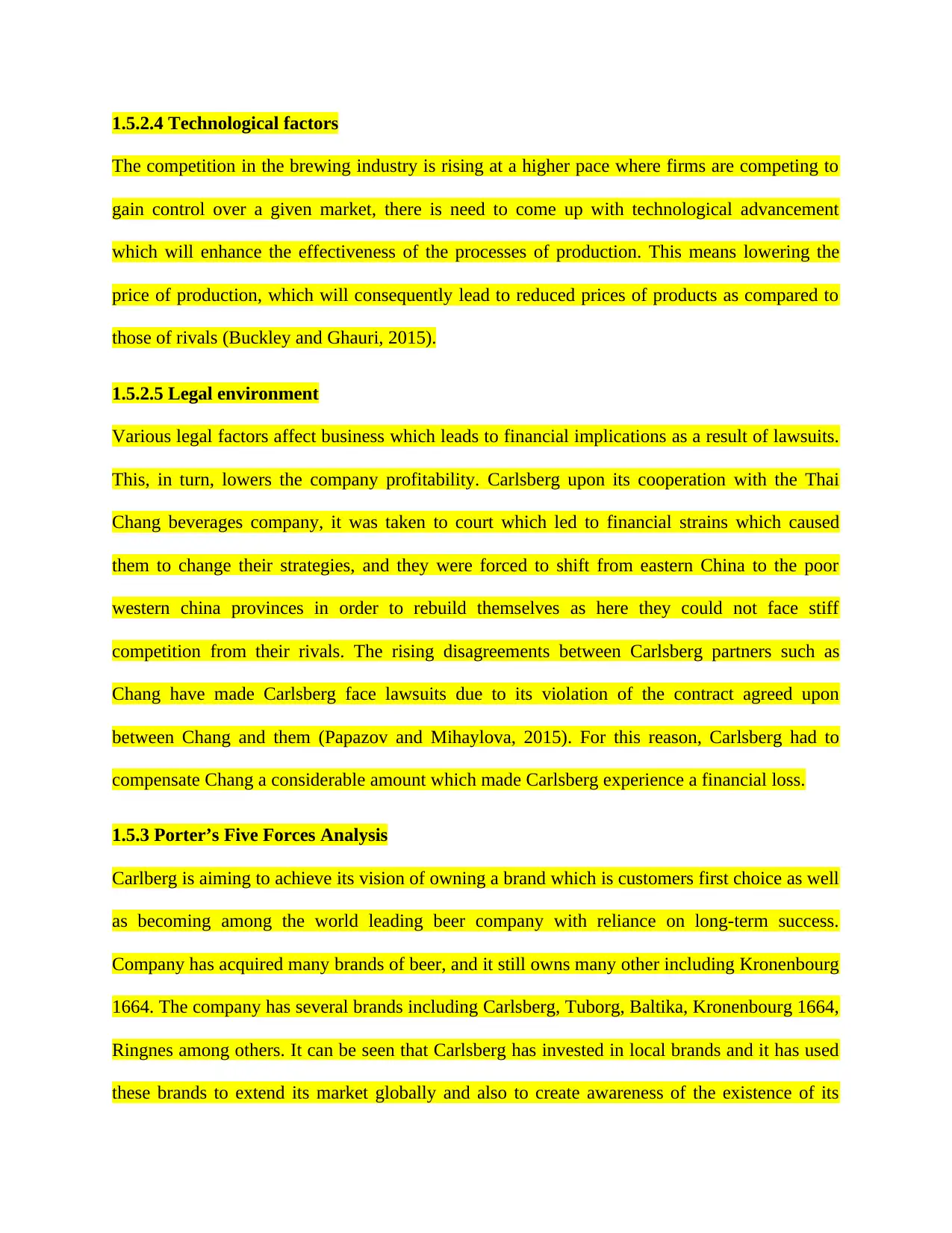
1.5.2.4 Technological factors
The competition in the brewing industry is rising at a higher pace where firms are competing to
gain control over a given market, there is need to come up with technological advancement
which will enhance the effectiveness of the processes of production. This means lowering the
price of production, which will consequently lead to reduced prices of products as compared to
those of rivals (Buckley and Ghauri, 2015).
1.5.2.5 Legal environment
Various legal factors affect business which leads to financial implications as a result of lawsuits.
This, in turn, lowers the company profitability. Carlsberg upon its cooperation with the Thai
Chang beverages company, it was taken to court which led to financial strains which caused
them to change their strategies, and they were forced to shift from eastern China to the poor
western china provinces in order to rebuild themselves as here they could not face stiff
competition from their rivals. The rising disagreements between Carlsberg partners such as
Chang have made Carlsberg face lawsuits due to its violation of the contract agreed upon
between Chang and them (Papazov and Mihaylova, 2015). For this reason, Carlsberg had to
compensate Chang a considerable amount which made Carlsberg experience a financial loss.
1.5.3 Porter’s Five Forces Analysis
Carlberg is aiming to achieve its vision of owning a brand which is customers first choice as well
as becoming among the world leading beer company with reliance on long-term success.
Company has acquired many brands of beer, and it still owns many other including Kronenbourg
1664. The company has several brands including Carlsberg, Tuborg, Baltika, Kronenbourg 1664,
Ringnes among others. It can be seen that Carlsberg has invested in local brands and it has used
these brands to extend its market globally and also to create awareness of the existence of its
The competition in the brewing industry is rising at a higher pace where firms are competing to
gain control over a given market, there is need to come up with technological advancement
which will enhance the effectiveness of the processes of production. This means lowering the
price of production, which will consequently lead to reduced prices of products as compared to
those of rivals (Buckley and Ghauri, 2015).
1.5.2.5 Legal environment
Various legal factors affect business which leads to financial implications as a result of lawsuits.
This, in turn, lowers the company profitability. Carlsberg upon its cooperation with the Thai
Chang beverages company, it was taken to court which led to financial strains which caused
them to change their strategies, and they were forced to shift from eastern China to the poor
western china provinces in order to rebuild themselves as here they could not face stiff
competition from their rivals. The rising disagreements between Carlsberg partners such as
Chang have made Carlsberg face lawsuits due to its violation of the contract agreed upon
between Chang and them (Papazov and Mihaylova, 2015). For this reason, Carlsberg had to
compensate Chang a considerable amount which made Carlsberg experience a financial loss.
1.5.3 Porter’s Five Forces Analysis
Carlberg is aiming to achieve its vision of owning a brand which is customers first choice as well
as becoming among the world leading beer company with reliance on long-term success.
Company has acquired many brands of beer, and it still owns many other including Kronenbourg
1664. The company has several brands including Carlsberg, Tuborg, Baltika, Kronenbourg 1664,
Ringnes among others. It can be seen that Carlsberg has invested in local brands and it has used
these brands to extend its market globally and also to create awareness of the existence of its
Paraphrase This Document
Need a fresh take? Get an instant paraphrase of this document with our AI Paraphraser

brands in numerous geographical locations (Ewins, 2013). Other similar companies to Carlsberg
are doing the same thing to expand their market such as InBev which exist in 6 geographical
locations with more than 200 brands of beer in 23 countries and this make InBev more present in
the market place than Carlsberg (Buckley and Ghauri, 2015). Carlsberg can be said to be a very
competitive company even though it appears not to exist in many countries, but this does not
limit the company from being more competitive than other companies, and this is the case with
China companies.
1.5.3.1 Threat of new entry
It is becoming extremely difficult and costly for Carlsberg to enter a new market. Best known
and well-established companies have dominated the North and Southern America markets.
Carlsberg inability to venture into these competitive markets have left it with an option to
venture into African markets and Western China region where there exists limited interest of
beer. Huge investments required to venture into the market place appears to be a for Carlsberg
and hence cannot compete effectively (Hitt et al., 2016).
1.5.3.2 Threat of substitutes
These include other products which serve the needs of consumer just the same way as beer does.
Existence of wine and spirits and the local brands pose a challenge to Carlsberg beer, meaning
that they have to ration their prices so that they can compete effectively with other substitutes of
beer. The consumption of beer has been falling, and this has been brought about by consumers
preference on consuming wine and spirits (Kotabe and Helsen, 2014).
1.5.3.3 Power of buyers
the local and non-premium brand has increasingly dominated the market where they comprise
95% of the total sales of beer. This means that the buying power of buyers is relatively low
are doing the same thing to expand their market such as InBev which exist in 6 geographical
locations with more than 200 brands of beer in 23 countries and this make InBev more present in
the market place than Carlsberg (Buckley and Ghauri, 2015). Carlsberg can be said to be a very
competitive company even though it appears not to exist in many countries, but this does not
limit the company from being more competitive than other companies, and this is the case with
China companies.
1.5.3.1 Threat of new entry
It is becoming extremely difficult and costly for Carlsberg to enter a new market. Best known
and well-established companies have dominated the North and Southern America markets.
Carlsberg inability to venture into these competitive markets have left it with an option to
venture into African markets and Western China region where there exists limited interest of
beer. Huge investments required to venture into the market place appears to be a for Carlsberg
and hence cannot compete effectively (Hitt et al., 2016).
1.5.3.2 Threat of substitutes
These include other products which serve the needs of consumer just the same way as beer does.
Existence of wine and spirits and the local brands pose a challenge to Carlsberg beer, meaning
that they have to ration their prices so that they can compete effectively with other substitutes of
beer. The consumption of beer has been falling, and this has been brought about by consumers
preference on consuming wine and spirits (Kotabe and Helsen, 2014).
1.5.3.3 Power of buyers
the local and non-premium brand has increasingly dominated the market where they comprise
95% of the total sales of beer. This means that the buying power of buyers is relatively low
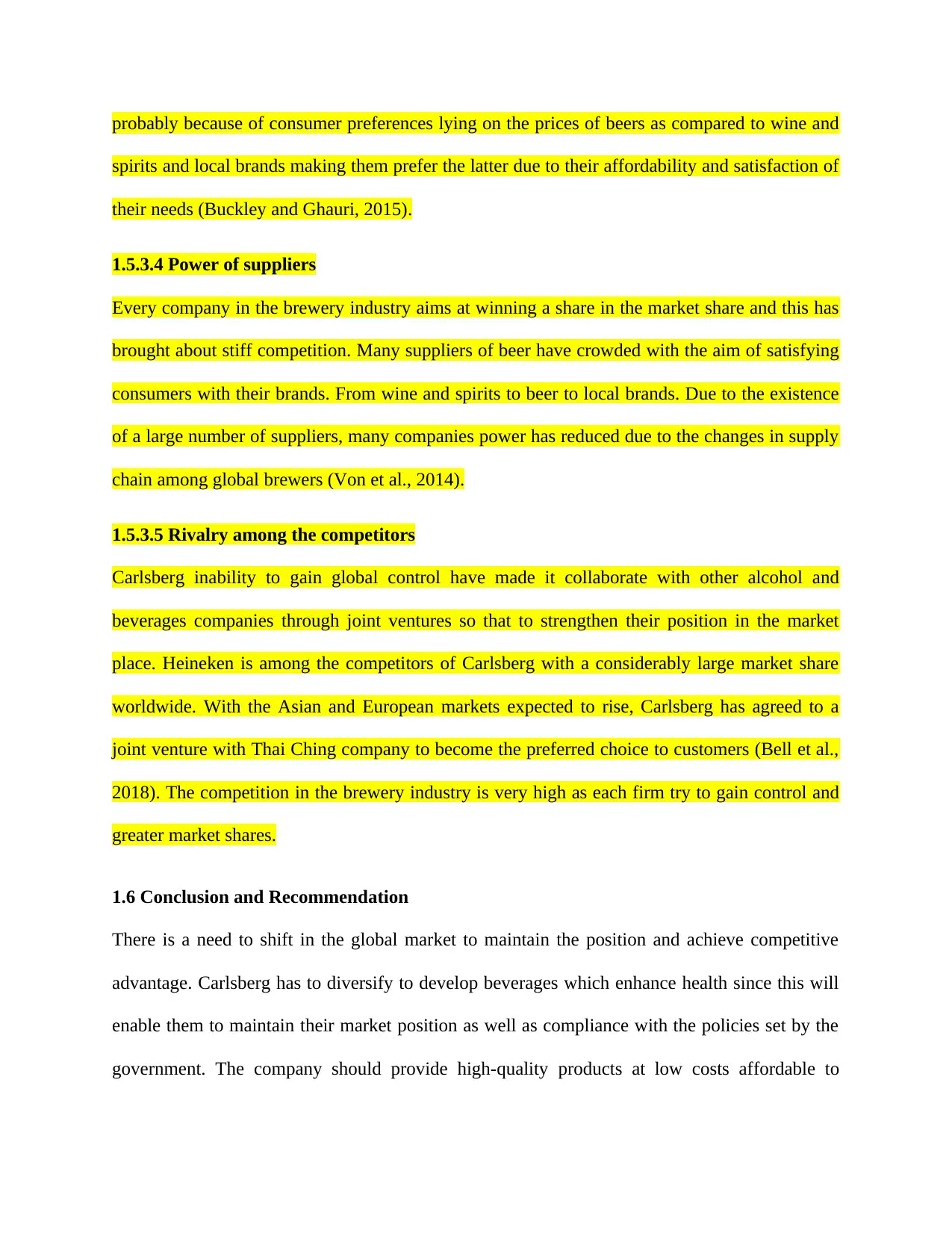
probably because of consumer preferences lying on the prices of beers as compared to wine and
spirits and local brands making them prefer the latter due to their affordability and satisfaction of
their needs (Buckley and Ghauri, 2015).
1.5.3.4 Power of suppliers
Every company in the brewery industry aims at winning a share in the market share and this has
brought about stiff competition. Many suppliers of beer have crowded with the aim of satisfying
consumers with their brands. From wine and spirits to beer to local brands. Due to the existence
of a large number of suppliers, many companies power has reduced due to the changes in supply
chain among global brewers (Von et al., 2014).
1.5.3.5 Rivalry among the competitors
Carlsberg inability to gain global control have made it collaborate with other alcohol and
beverages companies through joint ventures so that to strengthen their position in the market
place. Heineken is among the competitors of Carlsberg with a considerably large market share
worldwide. With the Asian and European markets expected to rise, Carlsberg has agreed to a
joint venture with Thai Ching company to become the preferred choice to customers (Bell et al.,
2018). The competition in the brewery industry is very high as each firm try to gain control and
greater market shares.
1.6 Conclusion and Recommendation
There is a need to shift in the global market to maintain the position and achieve competitive
advantage. Carlsberg has to diversify to develop beverages which enhance health since this will
enable them to maintain their market position as well as compliance with the policies set by the
government. The company should provide high-quality products at low costs affordable to
spirits and local brands making them prefer the latter due to their affordability and satisfaction of
their needs (Buckley and Ghauri, 2015).
1.5.3.4 Power of suppliers
Every company in the brewery industry aims at winning a share in the market share and this has
brought about stiff competition. Many suppliers of beer have crowded with the aim of satisfying
consumers with their brands. From wine and spirits to beer to local brands. Due to the existence
of a large number of suppliers, many companies power has reduced due to the changes in supply
chain among global brewers (Von et al., 2014).
1.5.3.5 Rivalry among the competitors
Carlsberg inability to gain global control have made it collaborate with other alcohol and
beverages companies through joint ventures so that to strengthen their position in the market
place. Heineken is among the competitors of Carlsberg with a considerably large market share
worldwide. With the Asian and European markets expected to rise, Carlsberg has agreed to a
joint venture with Thai Ching company to become the preferred choice to customers (Bell et al.,
2018). The competition in the brewery industry is very high as each firm try to gain control and
greater market shares.
1.6 Conclusion and Recommendation
There is a need to shift in the global market to maintain the position and achieve competitive
advantage. Carlsberg has to diversify to develop beverages which enhance health since this will
enable them to maintain their market position as well as compliance with the policies set by the
government. The company should provide high-quality products at low costs affordable to
⊘ This is a preview!⊘
Do you want full access?
Subscribe today to unlock all pages.

Trusted by 1+ million students worldwide
1 out of 16
Related Documents
Your All-in-One AI-Powered Toolkit for Academic Success.
+13062052269
info@desklib.com
Available 24*7 on WhatsApp / Email
![[object Object]](/_next/static/media/star-bottom.7253800d.svg)
Unlock your academic potential
Copyright © 2020–2025 A2Z Services. All Rights Reserved. Developed and managed by ZUCOL.




